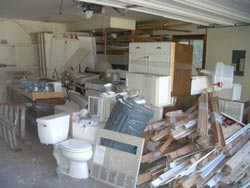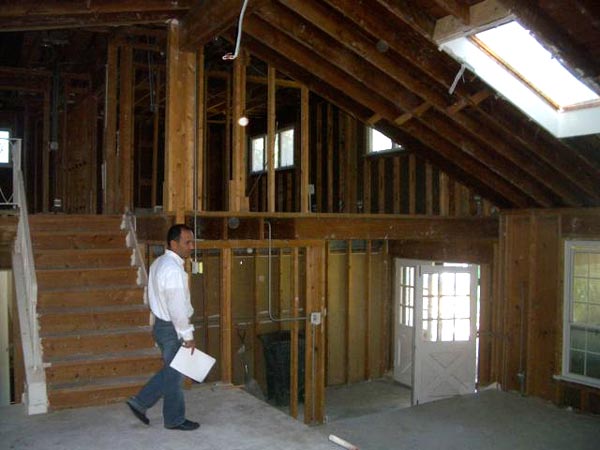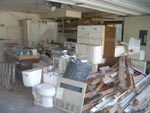|
Walk through what is left of the house that has been deconstructed, with Dennis and Robert Wolkoff, managing partner of Group One Investments. Click here for a larger version. |

Material already removed is organized in the garage, ready to re-use. |

Robert Wolkoff, managing partner of Group One Investments walks through the now deconstructed home. |
The developer who paid $1.2 million for a Northfield lot where he plans to build six condos could have had the old house there demolished in two days, at a cost of about $15,000. Instead, he’s paying twice that—and the demolition will take about two weeks.
But rather than end up in a landfill, something like 85 percent of the house’s building materials—such as the ductwork, the electrical wiring, and the stone around the fireplace—will be used to build or remodel other homes. Another 10 percent of the materials will be recycled. Just 5 percent of the remains of the four-bedroom tri-level house that once stood at 1884 Old Willow Road will wind up in the dump.
While he’s proud to have cut down on waste at his latest construction site, Robert Wolkoff, the managing partner of Group One Investments, points out that the sizable tax break involved makes his efforts financially feasible. “We can all do better and live well at the same time,” he says.
Trained contractors for ReUse People of America are actually dismantling the house. The organization—which started in Oakland, California, but now has branches in other cities—collects donated used building materials and resells them “at pennies on the dollar,” says Ken Ortiz, who runs the Chicago branch. Anyone can buy from The ReUse People, Ortiz says, although given the grab bag nature of the saved items and the lack of cachet attached to the process, you are unlikely to see these rescued fragments showing up in new luxury homes anytime soon. Remodelers on limited budgets and landlords of lower-rent places are the primary customers, Ortiz says.
Most of the materials from 1884 Old Willow won’t be sold; instead, they will be passed along to groups like Habitat for Humanity. The ReUse People doesn’t yet have a Chicago store for reselling materials; much of what it gets is warehoused in space donated by Finkl Steel until a store opens, which Ortiz says should happen in 2009. He is working with the City of Chicago now to find a facility.
As of Monday, the empty shell of a house at 1884 Old Willow looked as if some voracious looters had combed over the place, taking away everything inside, down to the studs. Trained “de-constructionists” from the ReUse People’s contractor have been working inside, taking out the appliances, toilets, millwork, ductwork, doors, sinks, electrical conduit, and everything else. “The only things they’re throwing away are the drywall and the roofing,” Wolkoff said. That goes into the giant Dumpster in the driveway. Ductwork, stair railings, and other metal is piled in the backyard; wood and appliances are heaped in the garage, where they are protected from the rain. The stone mantel lies in pieces in the front yard. A demolition permit is due from the village next week, and then the contractor will return to take apart the home’s exterior.
Once the house is gone, construction will begin on the Isabella, a set of six condos whose prices will range from $1.195 million to $1.295 million. The target market is empty nesters. “We’re making a place where these people [can] create a new beginning,” Wolkoff says. He’s done the same for the elements of the old house on the property.
 The developer who paid $1.2 million for a Northfield lot where he plans to build six condos could have had the old house there demolished in two days, at a cost of about $15,000. Instead, he’s paying twice that—and the..." />
The developer who paid $1.2 million for a Northfield lot where he plans to build six condos could have had the old house there demolished in two days, at a cost of about $15,000. Instead, he’s paying twice that—and the..." />



